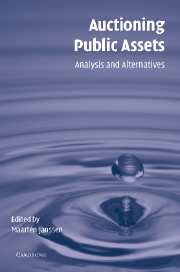Introduction
Published online by Cambridge University Press: 03 December 2009
Summary
Governments own many assets that are of genuine importance to society and that, for one reason or another, they do not want to exploit on their own. Examples include: mobile telephony frequencies, radio frequencies, airport slots, public infrastructure, land for different uses, high-voltage electricity cables, etc. In all these cases, a government needs to choose one or more private companies to use these assets in a proper way: it needs to select mobile telephony companies, (commercial) radio stations, airlines, rail (or other transport) operators, oil companies (if the land is designated for use as a petrol station). What all these cases have in common, besides the fact that the government has to choose who can use the public assets, is that the assets to be allocated are used to serve consumers in a market type of environment.
There are potentially many ways a government can allocate these assets. It can use auctions, Beauty Contests, first-come-first-served, grandfather rights and lotteries, to mention just a few of the most common allocation mechanisms. In auctions, firms typically have to make one or more financial bid(s) and the company with the highest bid wins the object to be allocated. In a Beauty Contest, firms have to submit a plan of how they will use the asset in the future and they have to provide credentials that make their plan trustworthy. A committee typically determines who wins the contest.
- Type
- Chapter
- Information
- Auctioning Public AssetsAnalysis and Alternatives, pp. 1 - 16Publisher: Cambridge University PressPrint publication year: 2004



